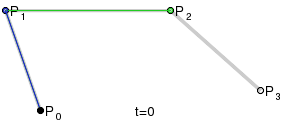How do I implement a Bézier curve in C++?
I\'d like to implement a Bézier curve. I\'ve done this in C# before, but I\'m totally unfamiliar with the C++ libraries. How should I go about creating a quadratic curve?
-
Here is a general implementation for a curve with any number of points.
vec2 getBezierPoint( vec2* points, int numPoints, float t ) { vec2* tmp = new vec2[numPoints]; memcpy(tmp, points, numPoints * sizeof(vec2)); int i = numPoints - 1; while (i > 0) { for (int k = 0; k < i; k++) tmp[k] = tmp[k] + t * ( tmp[k+1] - tmp[k] ); i--; } vec2 answer = tmp[0]; delete[] tmp; return answer; }Note that it uses heap memory for a temporary array which is not all that efficient. If you only need to deal with a fixed number of points you could hard-code the numPoints value and use stack memory instead.
Of course, the above assumes you have a vec2 structure and operators for it like this:
struct vec2 { float x, y; vec2(float x, float y) : x(x), y(y) {} }; vec2 operator + (vec2 a, vec2 b) { return vec2(a.x + b.x, a.y + b.y); } vec2 operator - (vec2 a, vec2 b) { return vec2(a.x - b.x, a.y - b.y); } vec2 operator * (float s, vec2 a) { return vec2(s * a.x, s * a.y); }讨论(0) -
You have a choice between de Casteljau's method, which is to recursively split the control path until you arrive at the point using a linear interpolation, as explained above, or Bezier's method which is to blend the control points.
Bezier's method is
p = (1-t)^3 *P0 + 3*t*(1-t)^2*P1 + 3*t^2*(1-t)*P2 + t^3*P3for cubics and
p = (1-t)^2 *P0 + 2*(1-t)*t*P1 + t*t*P2for quadratics.
t is usually on 0-1 but that's not an essential - in fact the curves extend to infinity. P0, P1, etc are the control points. The curve goes through the two end points but not usually through the other points.
讨论(0) -
Recently I ran across the same question and wanted to implemented it on my own. This image from Wikipedia helped me:

The following code is written in C++ and shows how to compute a quadratic bezier.
int getPt( int n1 , int n2 , float perc ) { int diff = n2 - n1; return n1 + ( diff * perc ); } for( float i = 0 ; i < 1 ; i += 0.01 ) { // The Green Line xa = getPt( x1 , x2 , i ); ya = getPt( y1 , y2 , i ); xb = getPt( x2 , x3 , i ); yb = getPt( y2 , y3 , i ); // The Black Dot x = getPt( xa , xb , i ); y = getPt( ya , yb , i ); drawPixel( x , y , COLOR_RED ); }With (x1|y1), (x2|y2) and (x3|y3) being P0, P1 and P2 in the image. Just for showing the basic idea...
For the ones who ask for the cubic bezier, it just works analogue (also from Wikipedia):

This answer provides Code for it.
讨论(0) -
Did you use a C# library earlier?
In C++, no standard library function for Bezier curves is available (yet). You can of course roll your own (CodeProject sample) or look for a math library.
This blogpost explains the idea nicely but in Actionscript. Translation should not be much of a problem.
讨论(0) -
If you just want to display a Bezier curve, you can use something like PolyBezier for Windows.
If you want to implement the routine yourself, you can find linear interpolation code all over the Intarnetz.
I believe the Boost libraries have support for this. Linear interpolation, not Beziers specifically. Don't quote me on this, however.
讨论(0)
- 热议问题

 加载中...
加载中...